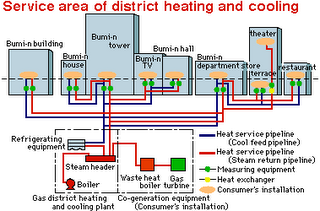
Determining feasibility of a District Cooling and Heating system
A district energy system gets an edge over individual central plans in utilizing the diversity of load on a big campus. Instead of sizing individual units at peak load you size the district energy equipment for the combined peak load of the facility. This lends very well to large facilities where demands vary at different places at different times of the day. College campuses where learning centers are mainly buys during day and residence facilities are mainly occupied at night provide perfect match for district heating and cooling application. Similarly a combination of office and residential buildings in a planned community is also a good candidate for district cooling and heating.
[Places where on-site power generation is being considered a combined power and heating-cooling plant (district cooling) is a logical choice.]
Besides utilizing the diversity of loads the other obvious advantage in centralization of cooling-heating plant is in reduced maintenance costs.
The facilities that are ideal for district cooling applications are where
i) the diversity in load is very high;
ii) the buildings are not too distant from each other (reducing the cost of distribution); and
iii) hiring service and maintenance personnel is very expensive.
All three of the above factors vary greatly with each facility. Thus there is a need to compare the cost of individual units with the cost of centralized plant for each potential district cooling-heating candidate. This seemingly complex task can be simplified by using approximate figures for:
i) cost/ton of cooling equipment,
ii) cost/ft of distribution system, and
iii) annual salary of maintenance personnel.
For cases where the cost differential between individual units and district cooling-heating unit is rather close, a more detailed analysis can be undertaken.
[Photo source: Hiroshima Gas Company]


0 Comments:
Post a Comment
<< Home